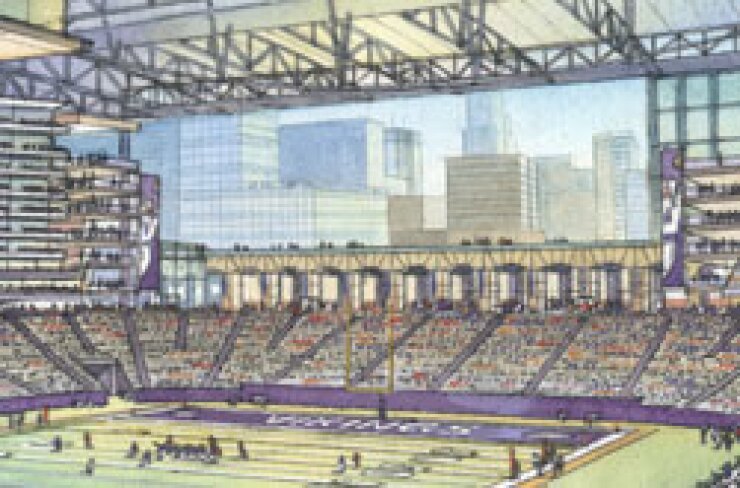
CHICAGO — Minnesota Gov. Mark Dayton — joined by the owners of the Minnesota Vikings, Minneapolis Mayor R.T. Rybak and lawmakers — on Thursday unveiled plans for a new $975 million Vikings stadium in downtown Minneapolis that relies on a team contribution and local and state funds.
The proposal comes after a series of false starts on stadium plans from local governments and other parties. The new proposal is the first to claim the support of so many key parties. Promoting the project as a job creator, Dayton called for quick legislative action, but it’s unclear whether the plan will pass muster with the Minneapolis City Council and the state Legislature.
“This agreement results from countless hours of analyses, discussions and negotiations,” Dayton said. “The project would provide up to 8,000 construction jobs and an additional 5,000 jobs among suppliers during its three years of construction, employ many more through its ongoing operations, and keep the Minnesota Vikings here for the next 30 years — all without using a single dollar of general fund tax revenues.”
State lawmakers said they were still finalizing language in a bill that would introduced Monday to the Legislature.
“We believe this proposal offers significant benefits for the city, the state, our fans and the team, and we look forward to working with the city of Minneapolis and the state Legislature to pass a stadium bill this year,” said Vikings owner Zygi Wilf.
The plan anticipates a 2016 opening. The National Football League stadium itself would cost $828 million to build with another $147 million spent on infrastructure and relocation costs. Minneapolis would contribute $150 million, the state $398 million and $427 million would come from the Vikings.
The city would face an additional $189 million over the 30-year lease for capital and operating expenses while the team would incur $327 million.
The state would repay bonds to cover its share with revenues from an expansion of charitable gambling through the addition of electronic pull-tabs.
Minneapolis would repay borrowing by redirecting a portion the existing 0.5% convention sales taxes and hospitality taxes that include a 3% downtown restaurant tax, a 3% downtown liquor tax and a 2.625% lodging tax. The plan also protects the city against covering cost overruns.
The stadium would be built adjacent to the Hubert H. Humphrey Metrodome where the Vikings currently play. The team, whose Metrodome lease has expired, would continue to play there for all but one year while the new stadium is under construction.
The public authority that owns and operates the Metrodome would be dissolved and a new stadium commission created with two city-appointed and three state-appointed members.
The plan calls for a fixed-roof stadium that would house 65,000 seats with the ability to expand to 72,000 to host events such as the Super Bowl. The Vikings would retain the right to profit from the sale of naming rights but the new authority would have veto power over the name.
The team has pressed for years to win public funding for a new home, warning that only with a new, more profitable venue could it remain competitive in its league and remain in Minnesota.
Its efforts failed even as the team watched its former Metrodome co-tenants — the Minnesota Twins and University of Minnesota Gophers — win new financial help for their new homes.
As momentum for legislative action built last year, the Vikings initially partnered with Ramsey County, which includes St. Paul, on a $1.1 billion stadium plan. It fell apart due to legislative opposition to the imposition of a sales tax without a public vote.





